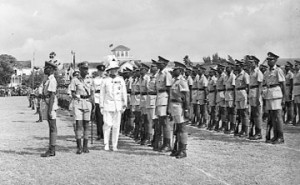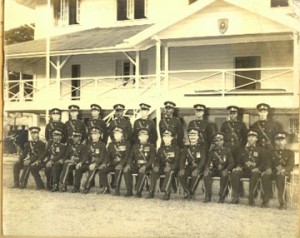The British Guiana Volunteer Force was established sixty years ago in June 1948. It was to be the second to last in a long line of military reserve forces that had been an honourable citizens’ tradition in this country for over 250 years. The Force was to survive only eighteen years until it was abolished in May 1966 to make way for the Guyana Defence Force.

After the final British conquest of the colonies from the Dutch, the existing ‘Burgher Militia’ was reorganised in 1806 to provide for a distinct unit for each colony – the Demerary (i.e., Demerara) Militia, the Essequibo Militia, and the Berbice Militia. That militia lapsed in the 1850s but was reorganised again in 1878 with the establishment of a Volunteer Force. When the West India Regiment was withdrawn, the British Guiana Militia was established in 1891.
Origins
The BG Militia was transformed into the British Guiana Regiment of the South Caribbean Force when the United Kingdom War Office assumed direct control over colonial defence during World War II. This regiment comprised seven companies of the British Guiana Home Guard; four were disbanded in 1945 after the war ended and three were retained under the name British Guiana Volunteer Corps. This Corps itself was disbanded in 1948.
The British Guiana Volunteer Force was established on 14th June 1948 by virtue of the Volunteer Ordinance. Its role was to assist the police whenever called upon to do so; to provide static guards on all essential works and installations; to provide armed escorts and patrols; and to assist in the restoration of law and order.

The Volunteer Force at first was placed under the command of the Commissioner of Police in his capacity of Commandant, Local Forces. In those days, the commissioner usually held the military rank of colonel and was responsible for the operational use of the Force. Next in line was the commanding officer, a part time officer with the rank of lieutenant colonel, who had responsibility for discipline, recruiting, training and other administrative matters.
It was not until the enactment of the Volunteer (Amendment) Ordinance on 11th July 1957 that this dual control ceased and the commanding officer was vested with full command authority under the direction of the governor. In its brief history, the Force had three commanding officers – lieutenant colonels Ernest Haywood, Charles Bernard and Celso de Freitas. It was in the same year (1957) that the British Guiana Militia Band was transferred to the British Guiana Police Force to become what is now the Guyana Police Force Band.
Organisation
The Volunteer Force was structured like what was then a typical British territorial battalion with an authorised maximum strength of 600 officers and men. By 1963, manpower was organised into a battalion headquarters, a headquarters company and five rifle companies. The battalion headquarters and ‘A’ and ‘C’ companies were located at Eve Leary, Georgetown, and ‘B’ company, in New Amsterdam, Berbice. ‘D’ company was formed in Mackenzie in the Upper Demerara River in 1957 and ‘E’ company was formed on the West Coast Demerara in 1963.
As the name suggests, service was voluntary and on a part-time basis. Recruits were drawn initially from ex-servicemen of the South Caribbean Force who had served with the British Guiana Regiment during World War II and, hence, were reasonably experienced. As a result, many could be appointed readily as officers, warrant officers and non-commissioned officers in the early days. Officers, previously commissioned on the basis of service during the war, were eventually promoted mainly from the ranks. Citizens were always anxious to enlist in the Force and there was no shortage of recruits. Service was for three years in the first instance but was renewable for a further period of three years, thereafter.
The Volunteer Force had responsibility for the Queen’s College Cadet Corps which was established in 1889. The Cadet Corps was trained by Volunteer Force instructors, was commanded by college masters who were also commissioned as volunteer officers and wore the Force’s cap badge.
Administration
The Force had its armoury, barracks, head offices stores and parade ground at Eve Leary, Kingston, Georgetown. The rifle range was located in Thomas Lands (on the present site of Camp Ayanganna) and the main field training area was located at Haywood Camp at Tacama in the Berbice savannahs, about 160 km upriver. Drill Halls were built in the towns of Mackenzie and New Amsterdam.
On a day-to-day basis, the force was administered by a permanent staff of 16 persons under the direction of the staff officer-adjutant who held the rank of major. His main duties were general administration, maintenance of stores, equipment and installations and supervision of personnel. He was responsible to two senior officers: first, to the commandant for the expenditure of funds and the militia band and, second, to the commanding officer for discipline, recruitment, training and organisation of the annual camp.
The Force was financed entirely by the government and, by 1963, it was estimated that its expenditure was approximately BWI$ 110,000 of which about $60,000 were expended on the annual camp alone. Members of the permanent staff were paid monthly salaries but reservists received a small stipend of one shilling (24 cents) for each attendance at a ceremonial parade or afternoon training session.
Most of the Force’s equipment was British-manufactured, bought through the Crown Agents. It possessed a light scale of infantry weapons − .303 No. 4 Mk 1 Enfield rifles; .303 Mk 1 Vickers machine guns; .303 Bren light machine guns;.380 revolvers and 9 mm Sten submachine guns.
Training
Annual training was divided into two periods. The first period − from January to June − was devoted to infantry skills and consisted of one drill period of one hour per week. During the second period − from September to November − emphasis was on the two-week training at Haywood Camp.
During the years 1953-1966, units of the British Army were usually based in the country to maintain public order. At these times, British troops would assist in providing advanced training to members of the Force at annual camp. This residential, tough, two-week training camp imparted skills in drill, fieldcraft, shooting and minor tactics, helping volunteers to keep abreast of modern military techniques.
The Force was embodied for active duty on full-time service on several occasions in response to civil disorder. During the emergencies in 1953 and 1954; 1962; 1963 and 1964, nearly 400 officers and men were called up to guard government and other vulnerable or vital industrial installations in Georgetown, New Amsterdam, Mackenzie and elsewhere. At these times, training would be suspended until normal conditions were restored.
Ceremonial
Volunteers were celebrated for their ceremonial parades of which the most spectacular were the presentation and trooping of the colours. The Force possessed two ‘colours.’ The Regimental Colour was presented on Saturday 18th March 1950 by Princess Alice, Countess of Athlone, at a ceremonial parade at Eve Leary, Kingston. At the presentation of the Queen’s Colour on Thursday 1st May 1958, Princess Margaret spoke of the “moving demonstration of loyalty and devotion to the throne.”
The Force would normally parade for the annual Remembrance Day and Queen’s Birthday observances and mount guards-of-honour for visiting dignitaries and the opening of the Legislative Council (now known as the National Assembly). A joint ceremonial parade was held on 23rd January 1960 to celebrate the Force’s alliance with the Worcestershire Regiment which was based in the country at that time. Another significant parade was held on Saturday 19th November 1960 to honour the Force’s grant of the freedom of the City by the Mayor and Councillors of Georgetown.
Members of the Force were eligible for two awards. The Efficiency Decoration was presented to officers of good conduct after twelve unbroken years of service. The Efficiency Medal was presented to warrant officers, non-commissioned officers and soldiers after a similar period of service. Clasps were presented to persons who already had received medals, after further periods of six years.
The South Caribbean Force’s colours of green and gold were retained in the Regimental Flag and lanyard. The flag consisted of a badge at the top of which was the royal crown − the symbol of authority; beneath was a laurel wreath enclosing the colonial emblem of a sailing ship encircled by a belt on which was written the motto, Damus Petimusque Vicissim; on a scroll at the bottom was the title, British Guiana Volunteer Force and this was backed by a pair of crossed swords, all set against a plain green background. Insignia of rank were patterned after those of the British Army.
Two main types of uniform were worn. Parade dress consisted of blue caps with red piping; blue jackets and trousers with red stripes; brass cap and collar badges, buttons and officers’ and warrant officers’ rank insignia; and black leather boots. Officers wore Sam Browne belts and carried swords. Other ranks wore white belts and bayonet frogs and carried rifles with white slings. Field dress, worn on training or operations, changed over the years. In the end, it consisted mainly of forage caps, khaki drill ‘bush’ jackets, trousers or shorts, boots, anklets, and web equipment (which included belts, ammunition pouches, water-bottles, bayonet frogs and haversacks) ; in the earlier days, side caps and puttees were worn.
Closure
The Volunteer Force operated under conditions of chronic crisis for much of its existence owing to the unsettled political conditions in this country, especially between 1953 and 1966. The government relied on the deployment of British Army troops to maintain public order and, as a result, evinced little interest in strengthening the Force which was under-trained, under-equipped and under-funded. As such, it was never given the opportunity to become an effective military organisation.
As the British governor had responsibility for the Volunteer Force, even under the internal self-government Constitution of 1961, the elected administration exercised no control over the Force. Not only could the elected administration do nothing to influence the Force’s administration, organisation and operations but it seemed to have regarded it with disfavour.
As independence approached, a decision was taken to disband the Volunteer Force. The British Guiana Special Service Unit, under the direct control of the British Governor and trained by the British Garrison, was brought into being in 1964. The following year, it was decided to establish a regular army − the Guyana Defence Force. The Defence Ordinance which brought the GDF into existence, also authorised the repeal of the Volunteer Ordinance and the disbandment of the Volunteer Force on 22 May 1966.
Notwithstanding the decision to disband the Force, however, several volunteers were re-employed in both the regular and reserve elements of the Guyana Defence Force. By 1969, for example, the first local-born GDF Chief of Staff, Colonel Clarence Price, and the commanding officers of the 1st and 2nd battalions – lieutenant colonels Robert Stephenson and Cecil Martindale, respectively – as well as several other officers and warrant officers in senior positions, were former volunteers.
It was a serious strategic error to disband the Force in 1966, disrupting a centuries-old tradition. This error was corrected ten years later in 1976 with the establishment of the Guyana People’s Militia but was repeated in 1997 when the very Militia also was relegated to a subordinate status as a battalion within the Guyana Defence Force.
The British Guiana Volunteer Force, despite its difficulties, did play a vital role in the transition from colony to independent state and in the maintenance of public order in the troubled pre-independence period. It also stood as a symbol of historical continuity of citizens’ irrepressible commitment to this country’s security.




